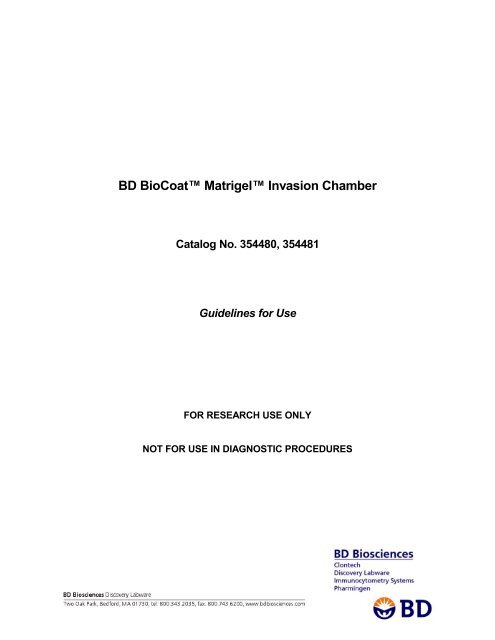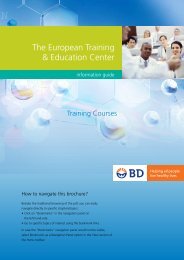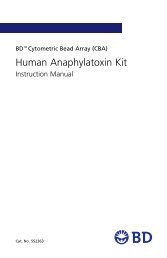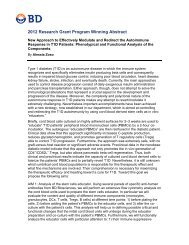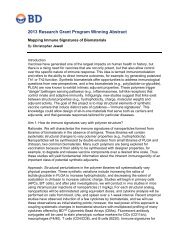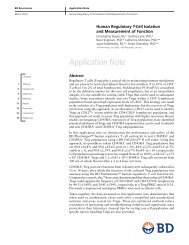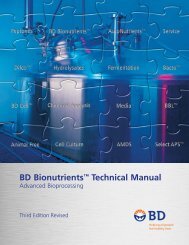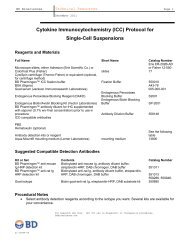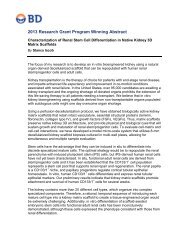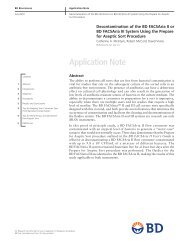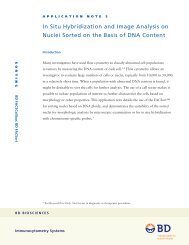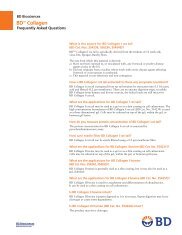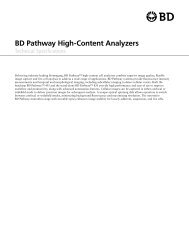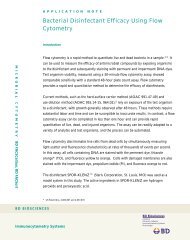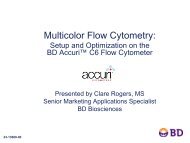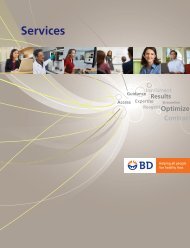BD BioCoat Matrigel Invasion Chamber - BD Biosciences
BD BioCoat Matrigel Invasion Chamber - BD Biosciences
BD BioCoat Matrigel Invasion Chamber - BD Biosciences
You also want an ePaper? Increase the reach of your titles
YUMPU automatically turns print PDFs into web optimized ePapers that Google loves.
<strong>BD</strong> <strong>BioCoat</strong> <strong>Matrigel</strong> <strong>Invasion</strong> <strong>Chamber</strong><br />
Catalog No. 354480, 354481<br />
Guidelines for Use<br />
FOR RESEARCH USE ONLY<br />
NOT FOR USE IN DIAGNOSTIC PROCEDURES
SPC-354480-G rev 9.0 Release Date: 9/14/01<br />
TABLE OF CONTENTS<br />
Page 1<br />
Intended use .................................................................................................................................. 2<br />
Summary ....................................................................................................................................... 2<br />
Materials Provided. ........................................................................................................................ 2<br />
Materials Required But Not Supplied............................................................................................. 2<br />
Precautions.................................................................................................................................... 3<br />
Procedure for Use.......................................................................................................................... 3<br />
1.0 Rehydration.............................................................................................................. 3<br />
2.0 <strong>Invasion</strong> Studies..................................................................................................... 4<br />
3.0 Measurement of cell invasion ................................................................................ 4<br />
Typical results................................................................................................................................ 7<br />
Stability .......................................................................................................................................... 7<br />
Technical Service........................................................................................................................... 7<br />
References .................................................................................................................................... 8<br />
NOTE: Process changes have been made to improve the performance and quality of <strong>BD</strong> <strong>BioCoat</strong><br />
<strong>Matrigel</strong> <strong>Invasion</strong> <strong>Chamber</strong>s.* Please review the following Sections for new information regarding<br />
product usage.<br />
PRECAUTIONS (b) (page 3): New storage conditions<br />
PROCEDURE FOR USE (page 3): Appearance of the <strong>Matrigel</strong> Basement Membrane Matrix<br />
PROCEDURE FOR USE, Section 1.0 Rehydration (page 3) New rehydration times<br />
PROCEDURE FOR USE, Section <strong>Invasion</strong> Studies (page 4): New suggested cell seeding densitiies<br />
* US Patent pending
INTENDED USE<br />
SPC-354480-G rev 9.0 Release Date: 9/14/01<br />
Page 2<br />
The <strong>BD</strong> <strong>BioCoat</strong> <strong>Matrigel</strong> <strong>Invasion</strong> <strong>Chamber</strong> is useful to study cell invasion of malignant and<br />
normal cells. Specific applications include assessment of the metastatic potential of tumor cells 1 ,<br />
inhibition of metastasis by extracellular matrix components 2 or antineoplastic drugs (taxol) 3 ,<br />
altered expression of cell surface proteins 4 or metalloproteinases 5 in metastatic cells, and invasion<br />
of normal cells, such as embryonic stem cells 6 , cytotrophoblasts 7 , and fibroblasts 8 .<br />
<strong>Invasion</strong> studies have been successfully performed on a variety of tumor cells (cell lines and<br />
primary tumors) including melanomas, glioblastomas, astrocytomas, osteosarcomas,<br />
fibrosarcomas, and adenocarcinomas of the lung, prostate, breast, ovary, and kidney.<br />
This product is FOR RESEARCH USE ONLY; NOT FOR USE IN DIAGNOSTIC PROCEDURES.<br />
SUMMARY<br />
<strong>BD</strong> <strong>BioCoat</strong> <strong>Matrigel</strong> <strong>Invasion</strong> <strong>Chamber</strong>s provide cells with the conditions that allow<br />
assessment of their invasive property in vitro. The <strong>BD</strong> <strong>BioCoat</strong> <strong>Matrigel</strong> <strong>Invasion</strong> <strong>Chamber</strong>s<br />
consists of a <strong>BD</strong> Falcon TC Companion Plate with Falcon Cell Culture Inserts containing an<br />
8 micron pore size PET membrane with a thin layer of MATRIGEL Basement Membrane Matrix.<br />
The <strong>Matrigel</strong> Matrix serves as a reconstituted basement membrane in vitro. The layer occludes<br />
the pores of the membrane, blocking non-invasive cells from migrating through the membrane. In<br />
contrast, invasive cells (malignant and non-malignant) are able to detach themselves from and<br />
invade through the <strong>Matrigel</strong> Matrix and the 8 micron membrane pores. The membrane may be<br />
processed for light and electron microscopy and can be easily removed after staining. The<br />
MATRIGEL <strong>Invasion</strong> <strong>Chamber</strong> is a convenient, ready-to-use system to study cell invasion in vitro.<br />
MATERIALS PROVIDED<br />
• <strong>Invasion</strong> <strong>Chamber</strong>s (24 inserts each)<br />
• Catalog # 354480 provided as 12 inserts in each of two 24-well <strong>BD</strong> Falcon TC Companion<br />
Tissue Culture Plates<br />
• Catalog # 354481 provided as 6 inserts in each of four 6-well <strong>BD</strong> Falcon TC Companion<br />
Tissue Culture Plates<br />
MATERIALS REQUIRED BUT NOT SUPPLIED<br />
• Bicarbonate based culture medium such as DMEM (serum-free)<br />
• Control Inserts (24-well, Catalog #354578 or 6-well, Catalog #354576)<br />
• Chemoattractant such as 5% fetal bovine serum in tissue culture medium<br />
• Companion Plates (24-well, Catalog #353504 or 6-well, Catalog #353502)<br />
• Humidified tissue culture incubator, 37 o C, 5% CO2 atmosphere
SPC-354480-G rev 9.0 Release Date: 9/14/01<br />
Page 3<br />
• Diff-Quik staining kit (Allegiance Catalog # B4132-1A) or other suitable fixative and stain<br />
• Laminar flow tissue culture hood<br />
• Scalpel (#11 blade recommended)<br />
• Microscope with (optional) camera<br />
• Microscope slides and coverslips<br />
• Cotton swab<br />
• Sterile forceps<br />
• Immersion oil<br />
PRECAUTIONS<br />
a.) The following procedure has been optimized using HT-1080 human fibrosarcoma<br />
cells. Results may vary depending upon the cells used and the specific conditions,<br />
especially those of medium, incubation time, cell seeding density, and<br />
chemoattractant, under which the procedure is performed. Individual researchers<br />
should optimize conditions for their system.<br />
b.) Storage: Materials should be stored at -20°C in the original packaging.<br />
c.) All procedures should be performed under aseptic conditions.<br />
California Proposition 65 Notice<br />
WARNING: This product contains a chemical known to the state of California to cause cancer.<br />
Component: Chloroform<br />
PROCEDURE FOR USE<br />
NOTE: The appearance of the <strong>Matrigel</strong> Matrix coating on the <strong>BD</strong> <strong>BioCoat</strong> <strong>Matrigel</strong><br />
<strong>Invasion</strong> <strong>Chamber</strong> has changed. The new glossy appearance is a result of process<br />
improvements, which have enhanced the performance and quality of the product.<br />
1.0 Rehydration<br />
Note: Refer to Table 1 below for volumes to be used for the 24-well (354480) or 6-well<br />
(354481) configurations of the <strong>BD</strong> <strong>BioCoat</strong> <strong>Matrigel</strong> <strong>Invasion</strong> <strong>Chamber</strong>s.<br />
1.1 Remove the package from -20°C storage and allow to come to room temperature.<br />
1.2 Add warm (37°C) bicarbonate based culture medium to the interior of the inserts
SPC-354480-G rev 9.0 Release Date: 9/14/01<br />
Page 4<br />
and bottom of wells. Allow to rehydrate for 2 hours in humidified tissue culture<br />
incubator, 37°C, 5% CO2 atmosphere.<br />
1.3 After rehydration, carefully remove the medium without disturbing the layer of<br />
<strong>Matrigel</strong> Matrix on the membrane.<br />
Table 1: Solution Volumes for <strong>Matrigel</strong> <strong>Invasion</strong> <strong>Chamber</strong>s<br />
24-well 6-well<br />
Rehydration of insert and well 0.5 ml (insert) and 0.5 ml (well) 2.0 ml (insert) and 2.0 ml (well)<br />
Well (i.e., chemoattractant) 0.750 ml 2.5 ml<br />
Cells 0.50 ml 2.0 ml<br />
Stain 0.50 ml 2.5 ml<br />
Rinse 150 ml 250 ml<br />
2.0 <strong>Invasion</strong> Studies<br />
2.1 Rehydrate the number of <strong>Matrigel</strong> inserts to be used as directed above. Prepare<br />
an equal number of Control Inserts by using sterile forceps to transfer them to<br />
empty wells of the <strong>BD</strong> Falcon TC Companion Plate.<br />
2.2 Prepare HT-1080 cell suspensions in culture medium containing 5x10 4 cells/ml for<br />
24- well chambers or 1.25x10 5 cells/ml for 6-well chambers. To determine the<br />
optimal seeding density for your cell type on a porous growth surface, we<br />
recommend using a range of seeding densities (cells/cm 2 ) that brackets the<br />
seeding density used on nonporous surfaces (i.e. flasks, dishes and plates). For<br />
example, if you currently seed at 10 5 cells/cm 2 , seed 0.5x10 5 and 5x10 5 cells/cm 2<br />
to determine the optimal initial seeding density.<br />
2.3 Add chemoattractant to the wells of the <strong>BD</strong> Falcon TC Companion Plate.<br />
2.4 Use sterile forceps to transfer the chambers and control inserts to the wells<br />
containing the chemoattractant. Be sure that no air bubbles are trapped beneath<br />
the membranes. This can be avoided by tipping the insert or chamber at a slight<br />
angle as it is lowered into the liquid.<br />
2.5 Immediately add 0.5 ml of HT-1080 cell suspension (2.5x10 4 cells) or your cell<br />
suspension to the 24-well chambers or 2.0 ml (2.5X10 5 cells) to the 6-well<br />
chambers.<br />
2.6 Incubate the <strong>BD</strong> <strong>BioCoat</strong> <strong>Matrigel</strong> <strong>Invasion</strong> <strong>Chamber</strong>s for 22 hours in a humidified<br />
tissue culture incubator, at 37 o C, 5% CO2 atmosphere.<br />
3.0 Measurement of cell invasion<br />
3.1 Removal of non-invading cells
SPC-354480-G rev 9.0 Release Date: 9/14/01<br />
Page 5<br />
Note: After incubation, the non-invading cells are removed from the upper surface of the<br />
membrane by “scrubbing”. The attachment of the membrane to the insert housing<br />
is quite firm and will not be dislodged during scrubbing nor will cells be dislodged<br />
from the bottom surface of the membrane. Scrubbing is very efficient in removing<br />
<strong>Matrigel</strong> Matrix and/or non-invading cells from the upper membrane surface.<br />
Scrubbing must be accomplished quickly to avoid drying of the cells<br />
adhering to the bottom surface of the membrane.<br />
a.) Insert a cotton tipped swab into the <strong>BD</strong> <strong>BioCoat</strong> <strong>Matrigel</strong> insert and<br />
apply gentle but firm pressure while moving the tip over the membrane<br />
surface.<br />
b.) Repeat the scrubbing with a second swab moistened with medium.<br />
3.2 Staining of cells<br />
Note: The cells on the lower surface of the membrane are stained with Diff-Quik stain.<br />
The Diff-Quik kit contains a fixative and two stain solutions. Staining is<br />
accomplished by sequentially transferring the inserts through the three solutions<br />
and two water rinses. The appearance is similar to that obtained by Wright-<br />
Giemsa staining. The cell nuclei stain purple and the cytoplasm stains pink.<br />
Suitable alternative staining procedures include fixation followed by hematoxylin<br />
and eosin staining or crystal violet. The membranes need not be removed from the<br />
insert housing for staining.<br />
a.) Add each Diff-Quik solution to three rows of a <strong>BD</strong> Falcon TC Companion<br />
Plate. Add distilled water to two beakers.<br />
b.) Sequentially transfer the inserts through each stain solution and the two<br />
beakers of water. Allow approximately > 2 minutes in each solution.<br />
c.) Allow the inserts to air dry.<br />
Alternatively, cells may be fixed and stained with 100% methanol and 1% Toluidine<br />
blue, respectively.<br />
a) Add 100% methanol to the appropriate number of wells of a <strong>BD</strong> Falcon<br />
TC Companion Plate. In a separate plate, add 1% Toluidine Blue in 1%<br />
borax to the appropriate number of wells. Add distilled water to two<br />
beakers.<br />
b) Transfer inserts into the methanol for 2 minutes.<br />
c) Transfer inserts into the Toluidine stain for 2 minutes.<br />
d) Rinse inserts in the two beakers of distilled water to remove excess stain.<br />
e) Allow the inserts to air dry.<br />
3.3 Counting of invading cells
SPC-354480-G rev 9.0 Release Date: 9/14/01<br />
Page 6<br />
Note: Cell counting is facilitated by photographing the membrane through the<br />
microscope. Direct counting of the cells at the microscope is also acceptable.<br />
a.) Remove the membrane from the insert housing by inverting the insert and<br />
inserting the tip of a sharp scalpel blade through the membrane at the edge<br />
adjacent to the housing wall. Rotate the insert housing against the<br />
stationary blade and the membrane will be released in much the same<br />
manner as the lid is cut from a tin can. Do not fully release the membrane<br />
from the housing but leave a very small point of attachment.<br />
b.) Use forceps to peel the membrane from the remaining point of attachment<br />
and place it bottom side down on a microscope slide on which a small drop<br />
of immersion oil has been placed. Place a second very small drop of<br />
immersion oil on top of the membrane.<br />
c.) Place a second slide or cover slip on top of the membrane and apply gentle<br />
pressure to expel any air bubbles.<br />
d.) Observe and/or photograph the invading cells under the microscope at<br />
approximately 40 - 200X magnifications depending on cell density. Count<br />
cells in several fields of triplicate membranes.<br />
Note: Cells will invade through the <strong>Matrigel</strong> on the 8 µm membrane pores ranging from<br />
even distribution to localization in discrete areas notably the center of the<br />
membrane and/or around the periphery of the membrane. When counting cells of<br />
triplicate membranes, choose fields in the center of the membrane as well as fields<br />
in the periphery of the membrane for ‘true’ representation of the cell number<br />
throughout the membrane.<br />
3.4 Data Reduction<br />
Note: Data is expressed as the percent invasion through the <strong>Matrigel</strong> Matrix and<br />
membrane relative to the migration through the Control membrane. The "<strong>Invasion</strong><br />
Index" is also expressed as the ratio of the percent invasion of a test cell over the<br />
percent invasion of a control cell.<br />
a.) Determine the Percent <strong>Invasion</strong>:<br />
Mean # of cells invading through <strong>Matrigel</strong> insert membrane<br />
% <strong>Invasion</strong> = -------------------------------------------------------------------------------- X 100<br />
Mean # of cell migrating through control insert membrane<br />
b.) Determine the <strong>Invasion</strong> Index:<br />
% <strong>Invasion</strong> Test Cell<br />
<strong>Invasion</strong> Index = -------------------------<br />
% <strong>Invasion</strong> Control Cell
TYPICAL RESULTS<br />
SPC-354480-G rev 9.0 Release Date: 9/14/01<br />
Page 7<br />
The following results are typical of those obtained when the <strong>BD</strong> <strong>BioCoat</strong> <strong>Matrigel</strong> <strong>Invasion</strong><br />
<strong>Chamber</strong>s (MIC) (Cat # 354480, 24 well format) are used as described to assess the invasion of<br />
HT-1080 fibrosarcoma test cells and NIH 3T3 control cells in a 18-24 hour assay, they are<br />
provided for reference only. Results will vary with different cell types, chemoattractants,<br />
and time.<br />
HT-1080<br />
NIH 3T3<br />
(test cells)<br />
(control cells)<br />
# cells invasion MIC<br />
(triplicate)<br />
78 63 77 6 2 5<br />
Mean 72.7 4.3<br />
# cell migration (control<br />
insert)<br />
206 168 182 177 151 175<br />
Mean 185.3 167.6<br />
% <strong>Invasion</strong> 72.7/185.3 x 100 = 4.3/167.6 x 100 =<br />
39.2%<br />
2.56%<br />
<strong>Invasion</strong> Index 39.3% / 2.56% = 15.3<br />
Due to the large membrane surface area (4.2 cm 2 /insert) of the <strong>BD</strong> <strong>BioCoat</strong> <strong>Matrigel</strong> <strong>Invasion</strong><br />
<strong>Chamber</strong>s in the 6 well format (Cat# 354481), this format may not be conducive to quantitative<br />
analysis of cell invasion for all cell types, However, the 6 well format is well suited for selecting<br />
"invasive" cell phenotypes from non-invasive cell phenotypes in response to a chemoattractant.<br />
Invaded cells are then removed from the bottom of the membrane for propagation and cell<br />
expansion. For quantitative measurements, we recommend the use of the 24-well format (Cat#<br />
354480).<br />
STABILITY<br />
The <strong>BD</strong> <strong>BioCoat</strong> <strong>Matrigel</strong> <strong>Invasion</strong> <strong>Chamber</strong>s are stable, for at least 3 months from date of<br />
shipment when stored at -20°C.<br />
TECHNICAL SERVICE<br />
For Technical Service/Questions call 1-800-343-2035.<br />
For Customer Service call 1-800-343-2035.
REFERENCES<br />
1. Albini, A. et al., Cancer Res. 47:3239 (1987)<br />
2. Kobayshi, H.et al., Cancer Res. 52:3610 (1992)<br />
3. Melchiori, A. et al., Cancer Res. 52:2352 (1992)<br />
4. Sterns, M. and Want, M., Cancer Res. 47:3776 (1987)<br />
5. Sato, H. et al., Nature 370: 61 (1994)<br />
5. Alexander, C.M. and Werb, Z., Cell Biol. 118:727 (1992)<br />
6. Cross, J.C. et al., Science 266: 1508 (1994)<br />
7. Chu, Y-W. et al., Proc. Natl. Acad. Sci. USA 90:4261 (1993)<br />
SPC-354480-G rev 9.0 Release Date: 9/14/01<br />
Page 8


